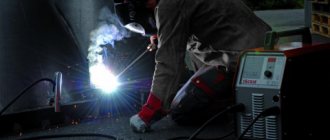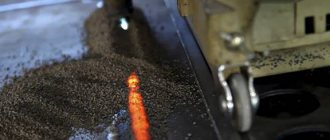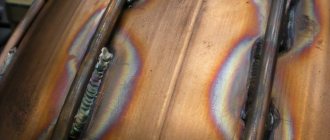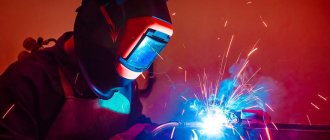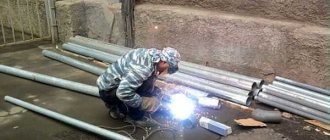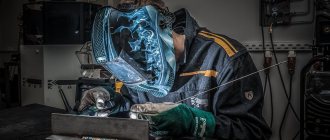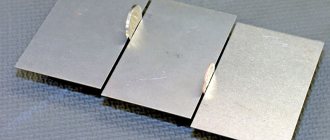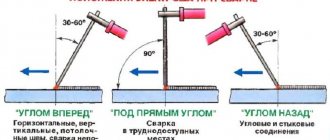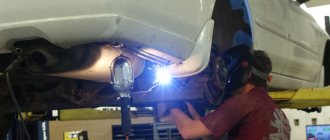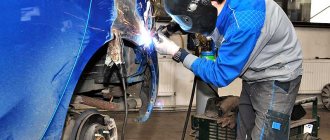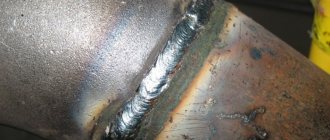04/30/2021 Author: VT-METALL
Issues discussed in the material:
- What are the basic principles of argon welding
- On what equipment is argon welding possible?
- What are the features of argon welding of aluminum and copper
Argon arc welding differs from all other types in that this process uses an electric arc with argon as a protective medium. Inert gas is supplied first to protect the metals from contact with oxygen during processing. From this article you will learn the basic principle of argon welding, as well as in what cases it is used.
What is the principle of argon welding based on?
Argon welding is a hybrid technology - thanks to it, it is possible to join metals that are considered the most difficult to work with. The principle of argon welding works great with both large pipes and tiny bronze figurines. The fact is that this method combines the best of two classical methods: electric arc and gas. The most common example of working with argon is welding stainless steel.
Before discussing the operating principle of argon welding, it is necessary to understand the physics of this process. It is no secret that joining metal surfaces is impossible without heating them. But since heating requires the use of fire, the oxygen contained in the air is also involved, which triggers the oxidation reaction. The problem is that complex metals or alloys such as alloy steels or non-ferrous metals are highly susceptible to oxidation.
Oxidation is dangerous because it significantly reduces the quality of the seams - they become fragile and quickly deteriorate. This occurs due to the formation of many tiny bubbles in the seam. If we talk about aluminum, it begins to burn when heated under normal conditions.
The principle of argon welding is used primarily to protect the welding pool from gases and impurities. Inert gases act as a protective shell; this can be not only argon, but also helium. However, a serious disadvantage of the latter is its high price and high consumption. For example, when processing stainless steel, several times more helium is required than argon. Another feature of using helium is that you cannot work with it without protective clothing that completely covers the body.
VT-metall offers services:
Due to what we described above, helium today is rarely used in its pure form; it is used in mixtures for gas lasers. Another inert gas is nitrogen. It is exclusively suitable for working with copper. Therefore, the main and most common inert component used in the hybrid approach is argon.
Let's name the main qualities of argon:
- Much heavier than air . It is thanks to this that it easily occupies the entire weld pool, protecting the melting zone from other gases.
- It is inert , therefore it does not react with other elements, but, most importantly, it does not interact in any way with the surfaces being welded - this is the principle of argon technology.
However, the principle of argon welding is not ideal, because when working with a current of reverse polarity, this gas turns into electrically conductive plasma. We will not go into detail when talking about the unpleasant consequences of this property.
In general, argon welding has few disadvantages:
- complex equipment that requires precise tuning;
- Possibility of work only if you have extensive practical experience.
This operating principle has many more advantages:
- The seam is of high quality, since it contains no impurities.
- Metal processing in an argon environment involves moderate heating of the metal, therefore it is suitable for joining workpieces of even very complex structures without deformation.
- This operating principle allows you to weld homogeneous and dissimilar metals and alloys that all other methods cannot cope with.
- High operating speed is achieved through the use of an arc with high temperature conditions.
All the disadvantages we have identified seem insignificant compared to the possibilities offered by argon welding.
Advantages and disadvantages
Argon arc welding has its advantages and disadvantages. Its key advantages are:
- The process provides a low heating temperature . This preserves the shape and size of the workpieces.
- The inertness of argon provides high protection of the welded area.
- The welding process is extremely simple and easy to learn (although it is not possible to start welding without training).
- The process uses a high-power arc , which ensures fast welding.
- The technology allows you to connect different types of metals that cannot be bonded in other ways.
- Requires rare electrode replacement.
The high quality of weld seams obtained by argon arc welding allows the method to be used in industries in which there is a high need for high-quality metal welding. In particular, the method can be used and has found distribution in the aviation, nuclear, food industries, medicine, and mechanical engineering.
Additional advantages of automatic welding are efficiency in joining several parts , as well as the elimination of human error. To maintain such an installation, a minimum number of personnel is required.
The disadvantages of the process are the complex welding equipment, in which it is difficult to adjust the modes . This limits the use of the method by beginners: the welder requires experience and dexterity. When a high-ampere arc is needed during the joining process, the welder needs to consider additional cooling of the joints.
also necessary to provide good protection from wind and draft so as not to lose argon protection, which complicates the practical application of the method. Therefore, it is recommended to perform such work indoors. With the manual method, the limitation of the method is the low cost of performing the work.
Limitations in the use of an automatic installation are the inability to weld any non-standard seams, the high cost of equipment, limitations on setting parameters; if the machine malfunctions, the entire batch of products may become defective.
Another disadvantage of this method is the high cost of argon . In practice, welders sometimes replace it with helium and carbon dioxide, but such a replacement is not always possible: it all depends on the type of metal to be welded.
Argon welding: principle of operation depending on type
Argon welding is usually divided into types based on the degree of mechanization:
- Manual . In this case, the welder independently moves the torch and feeds the welding wire. With this approach, only non-consumable tungsten electrodes can be used.
- A mechanized/semi-automatic technique in which a machine feeds the wire and the welder works directly with the torch. Most often, this principle is used when argon welding of stainless steel with a semi-automatic machine. Another striking example is mechanized argon arc welding with a consumable electrode. There are also new, highly specialized technologies in this area. These include semi-automatic processing of stainless steel in a carbon dioxide environment.
- Automatic argon welding. The operator remotely controls the machine: moves the torch and feeds the wire. Today, systems are gradually spreading that can operate even without constant human control. Most often, robots weld stainless steel pipes. Automatic argon arc welding using a non-consumable electrode is increasingly used in industry.
Manual welding of pipes in argon
Using manual argon welding of pipes, the root of the seam is formed in technological pipelines made of carbon, low-, medium-alloy and alloy steels, the diameter of which does not exceed 100 mm, and the wall thickness is 10 mm.
Process pipelines made of chrome-plated nickel alloys are also mounted by welding in a protective argon atmosphere. If the thickness of the pipeline walls does not exceed 3 mm, then they are welded only using argon-arc technology. If the pipe walls are thicker than 3 mm, then argon welding is used to form the root of the seam; further connection of pipeline elements is carried out using the argon-arc method using filler wire, manually using coated electrodes or mechanized welding methods.
If the distance between the pipes being welded does not exceed 0.5 mm, there is no need to use filler wire to connect them; if it exceeds, filler wire is required. If argon pipe welding is performed in windy or rainy weather, it is necessary to work in a special shelter.
To determine at what angle to place the electrode to the pipe being welded, it is necessary to focus on the quality of protection and design features of the torch. When using AGM-2 and AGS-3 burners, the angle can vary from 0° to 70°, when using other burners (AR-3, MG-3, etc.) with a channel gas flow pattern - from 0° to 25° .
If filler wire is used in the process of argon welding of pipes, it is fed into the working area from left to right, while the torch moves towards the wire, i.e. from right to left. When forming a root weld, the vibration amplitude of the torch and additive ranges from 2 to 4 mm. If further sutures are applied in the future, the burner is moved with transverse movements, the amplitude of vibrations of which varies from 6 to 8 mm. The melted end of the additive must be in a protective gas environment during welding. The wire feeding itself should occur smoothly, without sudden movements.
When manually argon welding pipes and other metal workpieces, use the shortest possible electric arc (about 1–3 mm), the current must be constant with reverse polarity. Light and extinguish the arc at the edge or at the seam of the elements being connected at a distance of 20–25 mm behind the crater. Argon begins to flow into the burner 15–20 seconds before the arc is activated, the supply of inert gas stops 10–15 seconds after the arc is extinguished. During these periods, the argon jet must be directed to the welding start zone or to the crater.
When welding pipes with argon, it is necessary to pay close attention to the root of the weld and sealing the crater. In the latter case, remote control of the electric arc power source is optimal. If it is not possible to control the arc remotely, then a drop of molten metal from the additive is introduced into the crater, while quickly moving the burner away from the joint area until the arc naturally breaks.
If welding work is performed without the use of filler wire, then to seal the crater, the torch is first quickly moved in the direction opposite to the movement, and then just as quickly returned back to the crater. After the root seam is formed, it is necessary to check its quality. If cracks or other defects are found, this area is removed using a narrow emery wheel, and then re-welded using an additive. When forming a root weld using a meltable insert, filler wire is not used; the insert is melted to the full depth and along the entire perimeter of the welded joint.
If the pipeline being welded has a small diameter, then the amount of argon used for purging should be no more than 3-4 l/min. The larger the diameter and length of the pipes being welded, the longer the purge time. To save inert gas, it does not fill the entire pipe cavity, but only the pipeline in the area of the welded joint, for which special plugs are used that limit the purge zone.
After the plugs are installed, inert gas is supplied through a special hose and fills the pipe cavity. This method has certain disadvantages. Since over 50% of argon is used for purging, which protects the work area, protecting the back side of the seam being formed costs twice as much as directly welding the joint. The increase in the cost of purging is affected by the need to manufacture and install plugs. If work is carried out with closing joints, then the entire cavity of the pipe is filled with inert gas.
To eliminate these shortcomings, welders use flux. Solder paste is applied at positive temperatures to the back side of the weld until it crystallizes. The paste dries in 15–20 minutes, the welder controls the process visually, focusing on its color (the dry mass will be dark gray).
Heat the joints using:
- flexible heating elements of the GEN type;
- combined heating elements of the KEN type;
- flexible inductors made of bare copper wire grade M or M1T with a cross section of 180–240 mm2 with 8–12 turns;
- gas flame burners.
After installation and fastening to the junction of funnels made of sheet asbestos, it is heated with single-tribe universal burners on a neutral flame. Their quantity is selected in such a way as to uniformly heat the welded joint along the entire circumference. Ring multi-flame burners are located on both sides of the junction of the workpieces.
Argon welding of pipes can be performed in rotary and non-rotary positions. In the first case, the pipeline axis can be located either vertically or horizontally. In the second, the seam is formed in two turns. If the length of the welded sections is more than 200 mm, the reverse-step method is used.
Argon welding of pipes with a diameter of less than 21.9 cm from martensitic and martensitic-ferritic steels is performed by one welder. To work with pipes of larger diameter, two specialists are required. If the pipe diameter exceeds 80 cm, then welding is performed by four welders working alternately.
Argon welding of pipes made of martensitic-ferritic steels is carried out at ambient temperatures above 0 °C; it is possible to work with pipes made of 15ХМ steel at air temperatures above +10 °C, while the workpieces, regardless of wall thickness, are heated to +250...+300 °C .
What equipment is used for argon welding?
The principle of argon welding requires the use of a variety of equipment. But there’s nothing wrong with that, because today you can buy ready-made kits with everything you need, and at an affordable price.
All equipment is divided into three types:
- Specialized - for working with workpieces of one type.
- Special – for industrial enterprises working with workpieces of the same standard size.
- Universal - for all types of work in argon, including for joining stainless steel parts with a semi-automatic device.
We recommend articles on metalworking
- Steel grades: classification and interpretation
- Aluminum grades and areas of their application
- Defects in metal products: causes and search methods
But you need to understand that the principle of argon welding is being improved. So, in order to process metal sheets with thicker edges and increase productivity, the technology was refined as follows:
- A special torch is used that allows the simultaneous use of several tungsten electrodes. This is necessary to obtain a high-quality seam, despite the high speed of work.
- There is a device for heating the wire.
- A pulsating current is used - pauses in its flow are needed so that the metal has time to crystallize. If the movement of the arc is synchronized with current pulses, it is possible to achieve effective melting at any position in space.
The burner is necessary for supplying electricity and forming gas protection, which is why its proper selection is so important. The principle of argon welding involves the use of a special torch with a non-consumable tungsten electrode, which is very important, for example, for welding stainless steel.
To understand the principle of operation in an argon environment, it is important to understand the technical characteristics of the burner:
- permissible value of welding current/power;
- type of cooling at high and low currents;
- cable length;
- the presence in the design of a ceramic nozzle and a tungsten electrode retainer;
- versatility, that is, the ability to connect the burner to different systems.
The main element of an argon burner is a reservoir with fittings for coolant. The tungsten electrode is connected to the electrical cable of the device, and an inert gas is supplied around the electrode.
How does the burner work?
- At the same time, the welding machine, coolant circulation, and gas supply to the torch are turned on, resulting in the formation of a protective cloud of argon.
- The arc is ignited, the workpieces are heated to the melting temperature, and the filler wire is placed in the working bath.
- The filler wire and tungsten electrode move along the weld.
1. Burner with a non-consumable electrode.
We are talking mainly about manual argon welding with a non-consumable electrode. This method is the only one possible for processing stainless steel and reactive metals, that is, aluminum, titanium and magnesium, using a tungsten electrode.
The burner consists of an electrode fixed in a current-carrying collet, a ceramic nozzle, which is used to direct the argon jet, and a cooling system using air or water. The diameter of the electrode is selected in accordance with the current strength used.
The operating principle of mechanized argon welding is somewhat different, so a different torch is used. It consists of a tungsten non-consumable electrode with a handwheel for raising and lowering, a current-carrying replaceable collet with a nut that allows the use of electrodes of different diameters.
Since this operating principle makes it possible to avoid metal spatter, gas-permeable mesh lenses are used along with ceramic nozzles - they are necessary for the formation of a uniform gas flow. Note that argon welding with a non-consumable electrode is one of the most popular approaches on a non-industrial scale.
2. Burner with a consumable electrode.
This type of operation is usually used in automatic and semi-automatic argon welding. The arc is fed between the end of the welding wire and the workpiece. Liquid and air cooling systems can be used. The principle of choosing a nozzle differs little from that used in the case of non-consumable electrodes.
Argon welding: operating principle
Welding safety
Almost all safety rules for welding in argon relate to preliminary preparation for the process. The likelihood of a hazardous situation occurring is minimal with proper preparation. Here are the basic principles for ensuring safety when welding using the argon method:
- The specialist has no right to carry out adjustment and repair procedures while the device is running..
- There must be at least 10 meters from the gas source to the fire source.
- During automatic welding, no manipulations are allowed . This can not only disrupt technology, but also harm health.
- Before starting work, you need to check the grounding of the welding machine, the reliability of the hose for supplying argon and water (if the torch is supposed to be cooled with water), check the seals on the pressure gauges, the threads on the union nuts, and the insulation of the holder handle.
- On automatic welding machines, a folding shield with a light filter is installed on the welder's side . Electrical wiring and tubes are contained in a common rubber hose. Burners must not have exposed live parts.
- The burner handles are covered with material and a shield that protects the welder’s hands from burns.
- During the welding process of some metals (in particular, copper and aluminum), toxic gases are released , so the room must be provided with good ventilation or an air supply.
- In exceptional situations, work should be carried out wearing a gas mask . In order to avoid burns from hot aluminum, molding spacers are used on horizontal seams, and movable curtains are used on vertical seams.
- Cleaning of aluminum additives in caustic soda solution should be carried out using rubber gloves and goggles for protection.
Thus, argon arc welding allows high-quality welding of special types of metals that cannot be joined by other methods. These are aluminum, copper and non-ferrous metals. With standard welding, it is not possible to obtain a high-quality and reliable seam for joining refractory workpieces. A special feature of welding is that it is carried out in a shielding gas environment. Argon provides reliable protection of the welding zone from the influence of external adverse factors.
The operating principle of argon welding using the inverter method
Today, the inverter method is the most popular principle of argon welding. It is used both in industry and at home. An inverter is an arc welding machine whose job is to convert direct current into alternating current. It is important that this device easily adapts to voltage surges in the electricity source.
The inverter machine is small in size and weight, yet reliable and excellent for welding work in any conditions. It is important that it can be used to train beginners.
In fact, if we compare the principle of inverter argon welding of stainless steel and working with other equipment, the first option turns out to be simpler and more convenient. The fact is that the welder is only required to move the torch along the seam. The result is also pleasing - the seam turns out thin and even, but only on condition that all technological requirements are met. Work is possible without filler wire if it is possible to achieve a very tight connection of the edges of the workpieces.
Inverter welding machines
The most popular welding device for argon welding, which can be successfully used not only in production, but also in everyday life, is an inverter machine. For those who want to learn how to weld with argon, using a welding inverter is the best option, since even a novice welder who does not have extensive professional skills can understand the principle of its operation by studying “Argon arc welding, instructions.”
An inverter argon arc welding machine has a number of significant advantages:
- High quality characteristics of the weld seam, which allows this equipment to be used for car repairs: welding assemblies and body parts, gearboxes, and engines.
- Small dimensions and light weight compared to transformer devices.
- Easy to use. To start work, you need to lay the filler wire and turn on the device. The wire and inert gas supply are switched on automatically.
As a rule, such modern devices are equipped with a number of additional options and protective devices, such as accelerated ignition, arc stabilization, and welding current modulation.
In total, more than 60 types of metal welding are known. If you need to cut metal quickly and efficiently, use gas cutting for this. Read more in this article.
If you are a beginner jeweler, then the article on https://elsvarkin.ru/materialy/cvarka-cvetnyx-metallov-texnologiya-svarki-medi/ link will be useful to you.
How to choose an operating mode without violating the basic principles of argon welding
The quality of the weld largely depends on the choice of welding mode.
The direction and polarity of the current are selected in accordance with the metals being processed. Thus, most steel-based alloys require polar direct current welding: this is the basis for the principle of semi-automatic welding of stainless steel and stainless steel pipes. For non-ferrous metals, aluminum, magnesium, alternating current of reverse polarity is suitable.
Argon consumption depends on its supply rate and external conditions: if you have to work outside in strong winds, the volume of required gas increases significantly.
It may seem strange, but up to 5% oxygen is added to the argon gas mixture. In such small quantities, the latter helps cleanse harmful impurities, as they react with it and simply burn out.
Text list of argon arc welding equipment produced by ITS:
- Installation for argon-arc welding Faltig – 400
- Device DC 200A.33 (up to 200A)
- Arc welder simulator DTS-02
- Installation for argon arc welding VD-306DK, VD-506DK
- Installation for argon arc welding UDG-180
- Installation for argon arc welding UDGU-200
- Installation for argon arc welding UDGU-251
- Installation for argon arc welding UDGU-351
- Installation for argon-arc welding UDGU-501 AC/DC
- Installation of Argon-arc welding TransTIG - 350
- Installation of Argon-arc welding TransTIG - 500
- Installation for argon arc welding TIG-200P AC DC BIMArc Standard Line
- Installation for argon arc welding TIG-315BP AC DC BIMArc Standard Line
Welding aluminum using the argon welding principle
As we have already said, it is impossible to weld aluminum without using an argon environment. The fact is that upon contact with oxygen contained in the air, an oxide film immediately forms on this metal. And this becomes a really serious problem because, although aluminum is one of the most difficult to process, it is most often used for domestic purposes.
Melting the oxide film requires a temperature significantly higher than the melting point of the metal itself. The principle of argon welding of aluminum is based on the fact that this gas prevents the oxidation process, displacing oxygen from the welding working pool. As a result, the aluminum filler wire melts easily and a high-quality weld is obtained.
The principle of working with this metal involves using only alternating current. The reverse polarity current significantly increases the melting temperature due to special cathodic cleaning of the oxide film. High temperatures lead to the destruction of even refractory tungsten in the electrode. The direct polarity current does not allow penetration of the oxide film, but the arc is stable and short. As you understand, the strength and appearance of the seam depend on switching polarity.
Working with direct current during argon processing of aluminum is possible, but only if pure helium is used as an inert gas. This processing option will cost much more, and the principle of operation itself is more complex from a technical point of view.
It is very important to properly prepare the aluminum blanks before starting the melting process. The quality of the future seam directly depends on this. During cleaning you need to perform the following steps:
- degrease the metal using a solvent;
- clean the surface from the oxide film - cleaning can be mechanical or chemical;
- Allow cleaned surfaces to dry completely.
Welding copper using the argon welding principle
Copper differs from other metals in that it is highly resistant to rust and is resistant in aggressive environments. Therefore, for its welding, argon of the highest grade is required or in combination with helium (and there should be more argon). Consumable or non-consumable tungsten electrodes and direct current are used.
Preheating to +800 °C is used in cases where the thickness of the copper billet exceeds 4 mm. The filler wire can be made of copper or copper-nickel alloy. The arc in this case must have high stability.
Since copper has high thermal conductivity, the edges of the metal must be cut. If we are talking about a sheet up to 12 mm thick, only one-sided cutting can be done, while for thicker edges it is necessary to carry out double-sided cutting.
Preparing products for welding work
Consists of preparation of parts and filler material. Preparatory operations for products:
- editing;
- marking;
- cutting;
- edge processing;
- assembly.
Preparatory operations may vary depending on the type of metal and the purpose of the structure. Low carbon and alloy steels are treated before the process as follows:
- the ends of sheets and pipes are cut off;
- joints are sanded by hand or by machine;
- the edges are cleaned of dirt, rust and oil;
- degrease with acetone or alcohol.
Nickel: the welding area is polished to a shine and degreased.
Aluminum and alloys:
- are being bullied;
- washed;
- lighten;
- dried.
Copper and titanium are cleaned and degreased.
